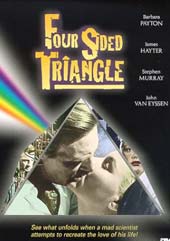 Hammer Films is one of the most beloved studios of horror hounds. Most notably for Hammer’s masterful retooling of Frankenstein, Dracula and The Mummy. Helming much of their finest work was legendary director Terence Fisher. While his bloody Curse of Frankenstein thrilled audiences and disgusted critics, one of his earlier pictures, Four Sided Triangle (1952, 81 minutes) is more cerebral. The pair do share a similar theme, as each feature men of science seeking to create life by their own hand — with disastrous results.
Hammer Films is one of the most beloved studios of horror hounds. Most notably for Hammer’s masterful retooling of Frankenstein, Dracula and The Mummy. Helming much of their finest work was legendary director Terence Fisher. While his bloody Curse of Frankenstein thrilled audiences and disgusted critics, one of his earlier pictures, Four Sided Triangle (1952, 81 minutes) is more cerebral. The pair do share a similar theme, as each feature men of science seeking to create life by their own hand — with disastrous results.
The movie: Three friends grow up together in England: Bill, Robin and the lovely Lena. Two fellas go off to school together, and become experimental scientists, while the object of their mutual affection, Lena (Barbara Payton), heads to the U.S. to find herself. Bill (Stephen Murray aka. The Fake Liam Neeson) is raised by the movie’s narrator, Dr. Harvey (James Hayter). Lena returns a complete failure and even contemplates suicide. The good doctor sets her to work tending to the cooking and cleaning needs of Bill and Robin (John Van Eyssen), as they feverishly work on a secret project. The two unveil their work to the doc by putting his pocket watch in an over-sized cake dish, roasting it with high-voltage current, until an exact duplicate materializes in another dish. Yeah, it’s about as thrilling as it sounds. Things get squirrely, though, when Bill loses Lena to Robin … and Bill decides he’ll use The Reproducer to improve his love life.
Notables: No breasts. Two corpses. Exploding laboratory. Soldering iron brandishing. Gratuitous montage sequences. Beach frolicking. Electroshock abuse.
Quotable: Bill whines, "In all my life, I’ve only wanted two things: knowledge and, I suppose, love. And I used the first to try and gain the second."
Time codes: An explanation of The Reproducer (17:50). The Earth-shattering engagement announcement (33:45). Tragic evidence of the world before Buns of Steel (1:02:55).
Final thought: It’s a talky flick that ends rather poorly. Still, the ’50s pseudo-science and notion of cloning chicks for fun and profit is intriguing.

